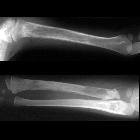Diffuse bony sclerosis
The causes of generalized increase in bone density in adult patients, also known as generalized or diffuse osteosclerosis, can be divided according to broad categories:
- hematological disorders
- myelosclerosis
- marrow cavity is narrowed by endosteal new bone
- patchy lucencies due to the persistence of fibrous tissue (generalized osteopenia in the early stages due to myelofibrosis)
- hepatosplenomegaly
- sickle cell disease
- osteosclerosing multiple myeloma
- myelosclerosis
- metabolic
- poisoning
- fluorosis
- with periosteal reaction, prominent muscle attachments and calcification of ligaments and interosseous membranes
- changes are most marked in the innominate bones and lumbar spine
- fluorosis
- neoplastic (more commonly multifocal than generalized)
- malignancy
- osteoblastic metastases: most commonly prostate and breasts
- lymphoma: infiltrative
- leukemia: infiltrative
- mastocytosis
- sclerosis of marrow-containing skeleton with patchy areas of radiolucency
- urticaria pigmentosa
- can have symptoms and signs of carcinoid syndrome
- idiopathic (more commonly multifocal than generalized)
- Paget disease: coarsened trabeculae, bony expansion and thickened cortex
- congenital: sclerosing bone dysplasias
- other
- hepatitis C associated osteosclerosis (HCAO)
There are several mnemonics for dense bones.
See also
Siehe auch:
- osteoblastische Knochenmetastasen
- diffuse bony sclerosis (mnemonic)
- Morbus Paget des Knochens
- Osteopoikilose
- Osteomyelofibrose
- Sichelzellenanämie
- Osteopetrose
- Renale Osteodystrophie
- Adenokarzinom der Prostata
- Pyknodysostose
- Fluorose
- Melorheostose
- Mastozytose
- Osteopathia striata
- sekundärer Knochenbefall bei Lymphom
- Leukämie
- osteomesopyknosis
- differential diagnosis of generalised increased bone density in adults
- sclerosing bony dysplasias
und weiter:
 Assoziationen und Differentialdiagnosen zu diffuse skelettale Sklerosierung:
Assoziationen und Differentialdiagnosen zu diffuse skelettale Sklerosierung:






































